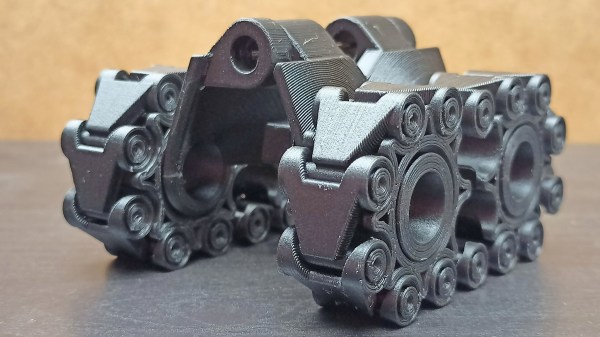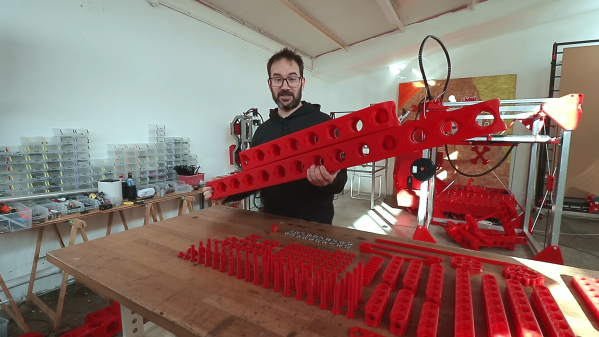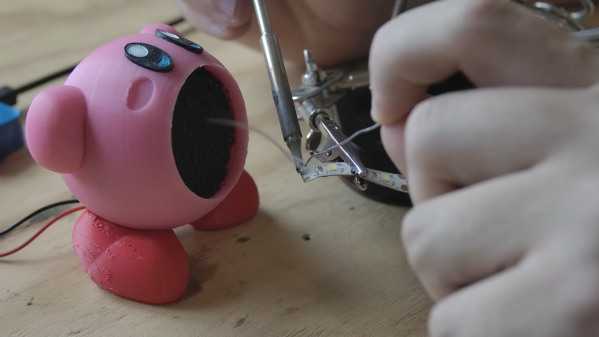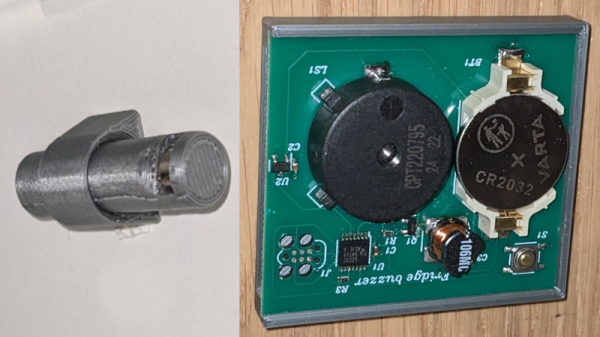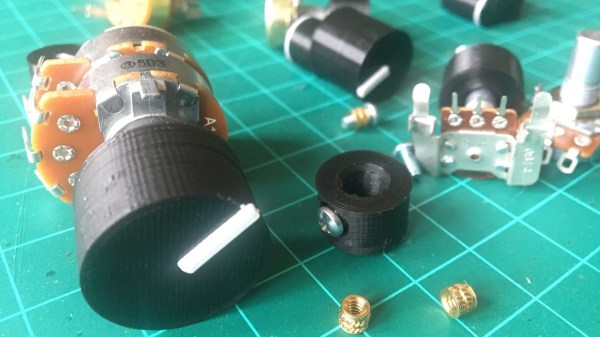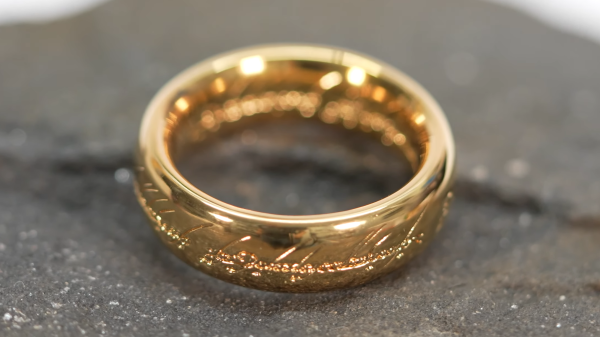Mattel holds a fond place in most people’s hearts as they made many of the toys we played with as kids. You might remember the Thingmaker, which was essentially an Easy Bake Oven with some goop and molds that let you make rubbery creatures. But back in 2016, Mattel had an aborted attempt to bring 3D printing to kids under the Thingmaker label. You can see a promo video of the device below. You might not have seen one in real life, though. The product was delayed and eventually canceled. Even so, we frequently see press releases for “kids printers” and we’ve been wondering, should this be a thing? Continue reading “Ask Hackaday: Do Kids Need 3D Printers?”
3d Printer hacks2762 Articles
One-Piece Tank Chassis Pushes Print-in-Place To New Heights
What’s better than 3D printing a tank chassis with working tracks? How about 3D printing the entire thing, moving parts and all, as a single piece? That’s [3D Honza]’s PiPBOT-1, and it’s the culmination of a whole lot of design work.
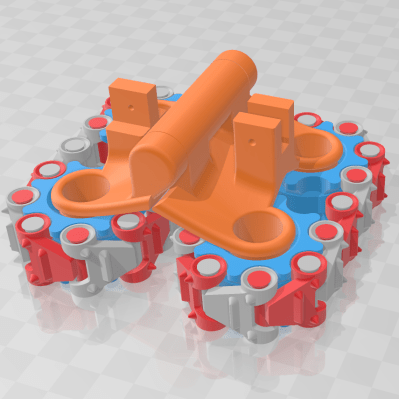
[3D Honza] has been sharing progress pictures and videos on his Twitter account, and just recently released the first version of his design. Version 1.0 is just the mechanics, but he’s already at work on version 2.0 which includes the ability to attach servos to drive the treads. At this writing, the design is currently downloadable directly from his site and includes CAD files, which is great to see.
One part of the design we’d like to draw your attention to is the chunky hinge that doubles as a kind of axial structure making up the body. This allows the tank to print in an unfolded state with the treads and wheels flat on the print bed. After printing, the tank gets folded up a bit like a taco to attain its final form. It’s a clever layout that allows the unit to be printed according to a filament-based 3D printer’s strengths, printing as a single piece that transforms into a small tank chassis, complete with working treads, in a few seconds.
When it comes to vehicles and bots, whether to choose wheels or tracks is a serious question our own Lewin Day has explained thoroughly. And for those of you who choose tracks, this design is great for small devices but don’t forget it’s always possible to go bigger when it comes to 3D-printed tanks.
Continue reading “One-Piece Tank Chassis Pushes Print-in-Place To New Heights”
3D Printing Giant LEGO-Like Blocks To Build Big Toys
[Ivan Miranda] is all about big 3D prints. He’s now set about printing giant blocks in the vein of LEGO Technic to build himself a full-sized rideable go kart. The project is still in progress, but [Ivan] has made great progress with his design.
The benefit of 3D printing giant blocks like this is that they open up the possibilities for rapid prototyping of big projects. It’s already easy to snap together a little LEGO tank, boat, or car at the small scale. Bigger blocks would make that possible for larger builds, too. Plus, once you’ve got plenty of blocks, there’s no need to wait for the 3D printer to churn out parts. You can just play with your toolbox of existing components.
[Ivan]’s design has faced some teething problems along the way. He struggled to solve various coupling problems for joining the blocks in various orientations, and made iterative changes to solve the issue. Eventually, he realized if he just eliminated an offset between the top and side holes of his beam design, everything would neatly work out. Plus, he learned that he could print a tiny scale version of his big blocks in order to test out designs without using as much plastic.
We love the idea of having a garage full of adult-sized LEGO-style blocks for big projects. The only caveat is that you really need a giant printer like [Ivan’s] to make them. Continue reading “3D Printing Giant LEGO-Like Blocks To Build Big Toys”
Kirby Sucks, Literally
What’s common between one of the most legendary video game characters of all time and a fume extractor ? They both suck. [Chris Borge] is not an electronics hobbyist and only does some occasional soldering. This made his regular fume extractor bulky and inconvenient to position where needed. What could serve him better would be a small extractor that could be attached to a clip or an arm on his helping hand accessory. Being unable to find an off-the-shelf product or a suitable 3d printed design that he liked, he built the Kirby 40mm Fume Extractor.
His initial idea was for a practical design more suited to his specific needs. But somewhere along the way, the thought of a Kirby fan popped up in his head, and it was too good an idea to pass up. Several Kirby fan designs already existed, but none that satisfied [Chris]. Getting from paper sketch to CAD model required quite an effort but the result was worth the trouble, and the design was quite faithful to the original character features. The main body consists of two halves that screw together, and an outlet grill at the back. The body has space for a 40 mm fan and a 10 mm charcoal filter in the front. The wires come out the back, and connect directly to a power supply barrel jack. Arms and eyes are separate pieces that get glued to the body. The feet glue to an intermediate piece, which slides in a dove tail grove in the body. This allows Kirby to be tilted at the right position for optimum smoke extraction.
While Kirby served the purpose, it still didn’t meet the original requirement of attaching to a clip or arm on the helping hand. So [Chris] quickly designed a revised, no-frills model which is essentially a square housing to hold the fan and the filter. It has a flexible stand so it can be placed on a bench. And it can also be attached to the helping hand, making it a more utilitarian design. This design has the charcoal filter behind the fan, but he also has a third design for folks who prefer to have the filter at the front.
He now had a more useful, practical fume extractor, but he couldn’t bring himself to discard his original Kirby. So he printed a couple more 3D parts so that Kirby could fit the end of his vacuum cleaner hose. Now, Kirby sits on his bench, and helps suck up all the bits and bobs of trash on his workbench. We’re sure Kirby is quite pleased with his new role.
Don’t Lose Your Cool With This Fridge Buzzer
[CarrotIndustries] wanted to add an audible warning for when the refrigerator door was left open. The result is a fridge buzzer that attaches to the inside of a fridge door and starts buzzing if the door is left ajar for too long.
The main components of the fridge buzzer consist of an MSP430G2232 low-power MCU connected to a SI7201 hall sensor switch, along with a CR2032 battery holder, push button and buzzer. The MSP430’s sleep mode is used here, consuming less than 3 µA of current which [CarrotIndustries] estimates lasting 9 years on a 235 mAh CR2032 battery.
A 3D printed housing is created so that the board slides into a flat bed, which can then be glued onto to the fridge door. The other mechanical component consists of a cylinder with a slot dug out for a magnet, where the cylinder sits in a mounting ring that’s affixed to the side of the fridge wall that the end of the door closes on. The cylinder can be finely positioned so that when the refrigerator is closed, the magnet sits right over the hall sensor of the board, allowing for sensitivity that can detect even a partial close of the fridge door.
All source code is available on [CarrotIndustries] GitHub page, including the Horizon EDA schematics and board files, the Solvespace mechanical files, and source code for the MSP430. We’ve featured an IoT fridge alarm in the past but [CarrotIndustries]’ addition is a nice, self contained, alternative.
Make Your Own Pot And Encoder Knobs, Without Reinventing Them
Rotary potentiometers, switches, and encoders all share a basic design: adjustment is done via a shaft onto which a knob is attached, and knobs are sold separately. That doesn’t mean one knob fits all; there are actually a few different standards. But just because knobs are inexpensive and easily obtained doesn’t mean it’s not worth making your own.
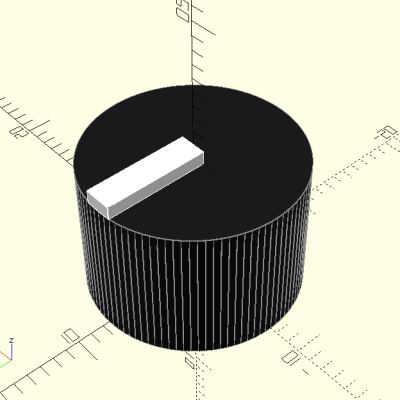
Why bother 3D printing your own knobs instead of buying them? For one thing, making them means one can rest assured that every knob matches aesthetically. The ability to add custom or nonstandard markings are another bonus. Finally, there’s no need to re-invent the wheel, because [Tommy]’s guide to making your own knobs has it all figured out, with the OpenSCAD script to match.
By default, [Tommy]’s script will generate a knob with three shims (for interfacing to a splined shaft) when pot_knob(); is called. The number of shims can be adjusted by modifying potKnobDefaultShimCount. To give the knob a flat side (to interface with D-shafts), change flatted = false to flatted = true. And for adding a screw insert suitable for a set screw? Change tightenerDiameter = 0 from zero to the diameter desired.
The script is quite comprehensive and has sensible defaults, but it does require a bit of knowledge about OpenSCAD itself to use effectively. We have covered the basics of OpenSCAD in the past, and if you’re ready for a resource that will help you truly master it, here’s where to look.
Making The One Ring By Electroplating Gold On A 3D Print
Electroplating is a great way to add strength or shine to a 3D print. However, we don’t see too many people trying it with gold. [HEN3DRIK] isn’t afraid to experiment, though, and pulled off some amazing, high-quality jewelry-grade plating!
The design for the project was the so-called Ring of Power from Lord of the Rings. The print was created on a resin printer at a high quality level, washed thoroughly to remove any remaining resin, and then cured. The print was then post-processed with sandpaper to make it as smooth as possible. Conductive paint was then applied, ready to take on the plating layers. [HEN3DRIK] first started by plating copper to build up a tough base layer, then nickel to prevent mixing between the copper and gold. The gold is then finally plated on top. Plating the copper is done with the ring constantly rotating to get as even a coat as possible. In contrast, the gold plating is done with a brush to avoid wasting the highly-expensive plating solution.
The final result is a gleaming gold ring that probably feels strangely light in the hand. The technique is time consuming, thanks to the need to plate multiple layers, but the results are to die for. We’ve seen [HEN3DRIK]’s fine work before, too. Video after the break.
Continue reading “Making The One Ring By Electroplating Gold On A 3D Print”


